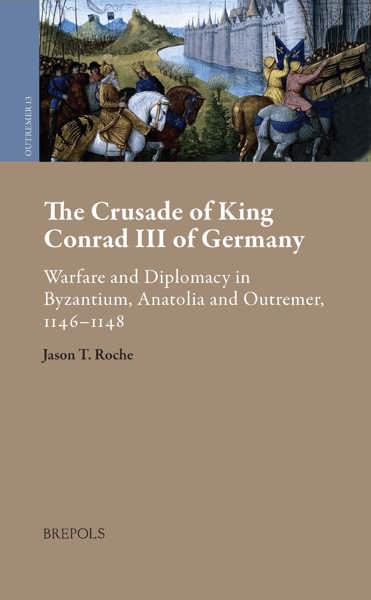
The Defence of the Faith
Crusading on the Frontiers of Latin Christendom in the Late Middle Ages
Paul Srodecki, Norbert Kersken (eds)
- Pages: 407 p.
- Size:156 x 234 mm
- Illustrations:26 b/w, 3 tables b/w.
- Language(s):English, German
- Publication Year:2024
- € 95,00 EXCL. VAT RETAIL PRICE
- ISBN: 978-2-503-58882-7
- Hardback
- Available
- € 95,00 EXCL. VAT RETAIL PRICE
- ISBN: 978-2-503-58883-4
- E-book
- Available
Research on the medieval crusades, their historical concepts, their course, and their social and regional range.
"Les contributions rassemblées dans ce volume montrent la vitalité d’un champ d’études défriché depuis la fin du XIXe siècle par notamment Nicolae Iorga puis Oskar Halecki, ce dont nous ne pouvons que nous féliciter, et elles donnent l’envie de mieux connaître les travaux des différents auteurs" (Jacques Paviot, in Francia-Recensio, 2024/4)
"...in general, this collection provides a series of valuable insights into often neglected tangled area of central and eastern European political history as well as suggesting fresh avenues for research." (Christopher Tyerman, in The Medieval Review, 11/01/2025)
"Vor allem aber haben die Herausgeber dazu beigetragen, Sachverhalte und Forschungsdiskussionen, die bisher am Rande der Geschichtsschreibung oder begrenzt in den lokalen Forschungstraditionen geblieben sind, einem größeren internationalen Publikum bekanntzumachen. Der Band macht auf aktuelle Forschungsdesiderate aufmerksam und wird der Forschung zukünftig neue Impulse geben." (Anti Selart, in Sehepunkte, 25, 7/8, 2025)
Paul Srodecki is a medievalist who has been working as an assistant and visiting professor, research fellow and lecturer at the universities of Giessen, Kiel and Flensburg (all three Germany), Ostrava (Czechia), Poznań (Poland) and Sønderborg (Denmark). He has published several treatises on alterity and alienity discourses, crusading on the frontiers of Latin Christendom as well as historical deconstruction.
Norbert Kersken holds a PhD from the University of Münster with a dissertation on medieval national historiography. He has been working as a Research and Teaching Fellow at the Herder Institute for Historical Research on East Central Europe in Marburg and at the University of Gießen, both Germany, as well as at the German Historical Institute in Warsaw, Poland. Together with Przemysław Wiszewski, he has published the monograph Neue Nachbarn in der Mitte Europas: Polen und das Reich im Mittelalter (2020).
This volume focuses on the complex and often overlooked topic of crusading activities and the crusade movement on the fringes of Latin Christendom in the time frame from approximately 1300 to the beginning of the sixteenth century. It covers a period widely considered as a time of significant political, cultural and religious changes in Europe. A period in which Western Christianity was on the one hand still expanding (vide Lithuania and the western Rus and later the Spanish, Portuguese, French and English expansion in the Americas, Africa and South-East Asia) and on the other hand facing two mighty opponents: the Ottoman Empire and Muscovy. On its eastern and southeastern frontiers, Latin Christian expansion came to a gradual halt — here, the West was now largely under siege! Alone the political, logistical and ultimately also military feasibility of a large-scale crusade to liberate Jerusalem had now receded into a purely theoretical and practically almost unenforceable far distance. Ranging in scope from the Baltic Sea region to the Balkans and Iberia, this book’s nineteen papers explore how these developments influenced the continuation and adaptation of crusading ideas and activities during this later period of crusades.
Introduction. Crusading on the Periphery in the Later Middle Ages: Key Research Issues and Debates
Paul Srodecki
Part I: Campaigning and Recruiting
Communication between Centre and Periphery in Fifteenth-Century Crusading
Norman Housley
Crusade Campaigning by Friars of the Observant Franciscan Establishment in the Holy Land
Marianne P. Ritsema Van Eck
Crusading and Military Orders in the Crowns of Aragon and Castile in the Late Middle Ages
Maria Bonet Donato
Army Inspection and Crusade. Wallachia and the Crusade Plans of Pope Leo X
Mihai-D. Grigore
Part II: Chivalry and Nobility
The Bohemo-Moravian Nobility and the Baltic Crusades of the Bohemian Kings Ottokar II Premislas and John of Luxemburg in the Thirteenth and Fourteenth Centuries
Dalibor Janiš
How to Uphold a Dying Institution. English Support for the Teutonic Order’s Baltic Crusades in the Early Fifteenth Century
Benjámin Borbás
Lithuanian Participation in the Crusading Movement in the Long Fifteenth Century
Darius Baronas
Part III: From Expansion to Defence
The Crusade of Nicopolis and its Significance for the Western Image of the Ottoman Turks around 1400
Paul Srodecki
Hungary and the passagium particulare after Nicopolis (1396–1437)
Attila Bárany
The Last Crusades in the Balkans from 1443– 44 or the Union between Central and South- Eastern Europe against the Ottoman Invasion
Nevyan Mitev
Converting Heretics into Crusaders on the Fringes of Latin Christendom. Shifting Crusading Paradigms in Medieval Bosnia
Emir O. Filipović
Ziel oder Ausgangsort? Das Großfürstentum Litauen als verlängerter Arm der Kreuzzugsbewegung vom Ende des 14. bis zum Beginn des 16. Jahrhunderts
Rimvydas Petrauskas
Fighting Pagans and Relations between Poland and the Teutonic Order after 1466
Adam Szweda
Part IV: Legitimation and Propaganda
Infideles et perfidi schismatici. Crusades and Christianisation as Political Tools of the Polish Kings in the Fourteenth Century
Andrzej Marzec
Against Tartari, Rutheni et Litfani, hostes fidei. The Role and Ambivalence of the Crusading Idea in the Integration of Ruthenia into the Polish Crown in the Second Half of the Fourteenth Century
Sven Jaros
Playing the Crusade Card. Rhetorical References to Outremer and Iberian Crusades in the Conflict between the Teutonic Order and the Crown of Poland in the Early Fifteenth Century
Paul Srodecki
Zwischen Kreuzzugsrhetorik und Bündnissen. Die Ostpolitik des Großfürsten Witold von Litauen (1392– 1430)
Sergey V. Polekhov
Legitimising the Hussite Wars. Anti-Heretical Crusading in the Fifteenth Century
Pavel Soukup




